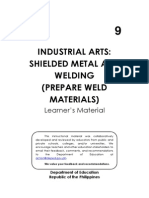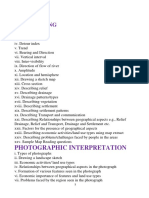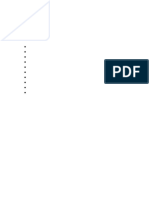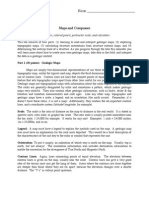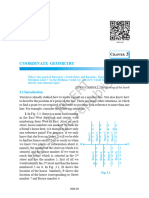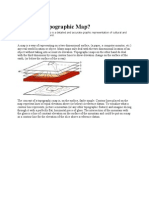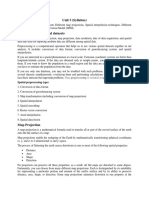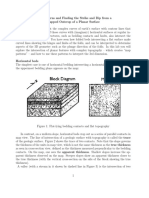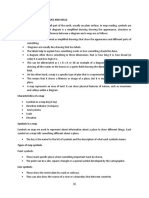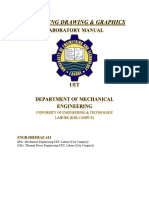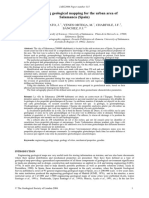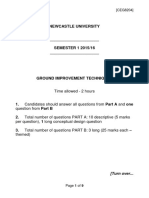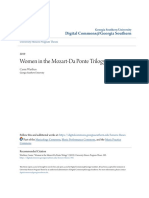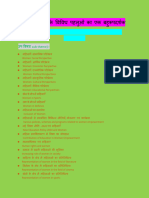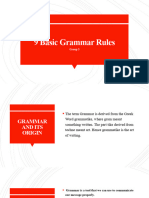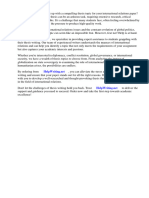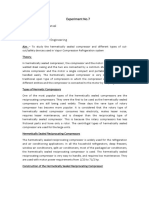0 ratings0% found this document useful (0 votes)
47 viewsTopographic Maps - Laboratory 8
Topographic Maps - Laboratory 8
Uploaded by
mastergeo35This document provides information about topographic maps and how to construct a basic topographic map model. It discusses key concepts like latitude and longitude, quadrangles, townships and sections. It then provides step-by-step instructions for building a simple clay model of a mountain, tracing contour lines at set elevations, and producing a topographic map and cross section representation of the model.
Copyright:
© All Rights Reserved
Available Formats
Download as PDF, TXT or read online from Scribd
Topographic Maps - Laboratory 8
Topographic Maps - Laboratory 8
Uploaded by
mastergeo350 ratings0% found this document useful (0 votes)
47 views6 pagesThis document provides information about topographic maps and how to construct a basic topographic map model. It discusses key concepts like latitude and longitude, quadrangles, townships and sections. It then provides step-by-step instructions for building a simple clay model of a mountain, tracing contour lines at set elevations, and producing a topographic map and cross section representation of the model.
Original Title
topoMapsLab8
Copyright
© © All Rights Reserved
Available Formats
PDF, TXT or read online from Scribd
Share this document
Did you find this document useful?
Is this content inappropriate?
This document provides information about topographic maps and how to construct a basic topographic map model. It discusses key concepts like latitude and longitude, quadrangles, townships and sections. It then provides step-by-step instructions for building a simple clay model of a mountain, tracing contour lines at set elevations, and producing a topographic map and cross section representation of the model.
Copyright:
© All Rights Reserved
Available Formats
Download as PDF, TXT or read online from Scribd
Download as pdf or txt
0 ratings0% found this document useful (0 votes)
47 views6 pagesTopographic Maps - Laboratory 8
Topographic Maps - Laboratory 8
Uploaded by
mastergeo35This document provides information about topographic maps and how to construct a basic topographic map model. It discusses key concepts like latitude and longitude, quadrangles, townships and sections. It then provides step-by-step instructions for building a simple clay model of a mountain, tracing contour lines at set elevations, and producing a topographic map and cross section representation of the model.
Copyright:
© All Rights Reserved
Available Formats
Download as PDF, TXT or read online from Scribd
Download as pdf or txt
You are on page 1of 6
1
Topographic Maps - Laboratory 8
______________________
(Name)
The most basic way that we navigate from location to location is by latitude and
longitude (see Figure 1). For example, 0
o
latitude follows the equator. Latitudinal lines
north or south of the equator increase to 90
o
at the poles. In contrast, longitudinal lines
run pole to pole, and 0
o
longitude runs through Greenwich, England. Longitude is
therefore expressed as so many degrees East or West of the principal meridian running
through Greenwich. Hence, it varies from 0
o
to 180
o
. One degree of longitude or latitude
is equal to 60 minutes while 1 minute is equal to 60 seconds. There are therefore 3600
seconds in one degree.
Figure 1. Latitude and longitude on a globe.
Quadrangle maps represent the three dimensional features of a segment of the Earths
surface and are bounded by a specified degree of latitude and longitude. Perhaps the
most common type of quadrangle map is the 7.5 minute variety, which is bounded by 7.5
minutes of longitude and 7.5 minutes of latitude.
Many of you at some time in the future will end up purchasing homes. Your deed will
express the general location of where your property is located. Hence, it is important that
you learn how to read and understand such information.
2
Government agencies, both local and federal, create so called townships, by arbitrarily
defining a base line (an arbitrary latitude), and an arbitrary principal meridian (an
arbitrary longitude). They then mark off from this starting point blocks that are 6 miles
by 6 miles in an EW and NS direction, and designate each block with a township and
range designation (See Figure 2).
In Figure 2, I is designated T2N, R3E.
(1) What would be the designation of II?
(2) What would be the designation of III?
Figure 2. A grid for a township.
Each Township is further subdivided into 36 sections, each section being 1 mile by 1 mile
in size. Hence, it can be thought of as consisting of 6 rows and 6 columns. The first row
3
consists of sections 1 through 6 numbered from east to west. The second row consists of
sections 7 through 12 numbered from west to east. This numbering continues in this
manner until the last section designated 36 is reached. In Figure 3 (a) please fill in the
missing section numbers.
Figure 3. Sections within a township.
Each section can be further subdivided into quarters (See Figure 3 (b)). For example, the
letter a in Figure 3(b) occupies the SE1/4 of sec 11, of T2N, R3E.
(1) What is the location of letter b?
(2) What is the location of letter c?
4
The principle way that we represent the 3D aspects of the Earths surface is through
topographic contours. Topographic contours represent the intersections of a series of
horizontal planes at a specific elevation above or below sea level with the Earths surface.
If you are walking along a topographic contour, then you would increase or decrease in
elevation. In other words topographic contours are curves marking points of equal
elevation.
In order to gain a better understanding of topographic contours we are going to build a
model of a quadrangle map. The tools that we will use are shown in Figure 4.
Figure 4. The tools that we will use in constructing a topographic map.
5
Please complete the following steps:
(1) Using some kind of clay build on a piece of plastic or sheet of paper a mountain
with variable slope and containing at least one ravine or valley. Your mountain
should be no taller than 4 cm at its highest point and should cover a surface area
of about 12 cm by 12 cm.
(2) The scale of your model is 5 cm =50 feet. Moreover, because there will be no
vertical exaggeration the above scale applies to both the vertical and horizontal
dimensions.
(3) Using the laser and the carpenters level, trace out on your model the intersection
of a horizontal plane at 50 feet and 100 feet with your model of a mountain. Use
a spatula to mark these positions.
(4) Place a clear plastic pan over your model, and tape it to the desk.
(5) Tape a clear piece of plastic to the pan, placing it directly over your model of a
mountain.
(6) Looking vertically over your model trace out the outline of your mountain, and
label it 0 feet.
(7) Looking vertically over your model trace out the 50 foot intersection and label it
50 feet.
(8) Looking vertically over your model trace out the 100 foot intersection and label it
100 feet.
(9) Locate the very top of your mountain and trace out an X on the clear plastic
overlay.
Remove your overlay, and draw out a line 4 cm long and label it scale. You may also
label one end of the line 0 and the other 200 feet.
You should also indicate the direction of North. For this lab we will make the long
dimension of the clear plastic sheet North.
Your clear plastic sheet now represents a topographic or quadrangle map of the your
model of a mountain. Please answer the following questions:
(1) How are topographic contours for shallowly inclined surfaces expressed relative
to topographic contours for steeply inclined surfaces.
(2) The so called contour interval is the minimum change in elevation represented
by topographic contours on a map. What is the contour interval for your map?
Finally, we are going to draw a topographic section through your modeled mountain. On
the clear plastic sheet containing your topographic map lay out a line all the way across
the map and label one end A and the other end A. Now transfer that line to a blank sheet
of paper and label A and A. Everywhere that the line crosses a contour place a tick and
6
label the elevation. Now draw a line segment 4 cm long extending from A upward at 90
degrees to A-A and scale off 50, 100, 150, and 200 feet segments. Do the same thing at
the opposite end of the line segment. You now have a kind of graph where the Y axis is
elevation above sealevel, and the X axis is position on the Earths surface along A-A.
Now graph the elevation points where A-A crosses the above identified topographic
contours and then connect the points with a smooth line. The results represents a
topographic cross-section through the modeled mountain.
You might also like
- BS 85500 2015 PDFDocument38 pagesBS 85500 2015 PDFmastergeo35No ratings yet
- Beverage Density Lab 1Document4 pagesBeverage Density Lab 1api-23821364650% (2)
- Uh Bahasa Inggris (Preposition of Place)Document3 pagesUh Bahasa Inggris (Preposition of Place)nailu hanun al haq87% (15)
- Ia - Smaw - Prepare Weld Materials PDFDocument36 pagesIa - Smaw - Prepare Weld Materials PDFJanus Salinas85% (20)
- Mapwork, Photographic Interpretation, FieldworkDocument135 pagesMapwork, Photographic Interpretation, FieldworkTusiime86% (7)
- Geography Map ReadingDocument20 pagesGeography Map ReadingWakale NzakoNo ratings yet
- Blyth 1990 Useful MapsDocument68 pagesBlyth 1990 Useful Mapsmastergeo35No ratings yet
- Bob BoyceDocument47 pagesBob BoyceDmitryRussuNo ratings yet
- Physical Geography MsceDocument96 pagesPhysical Geography MsceYamikani Micah100% (2)
- Map OrientationDocument11 pagesMap Orientationgreyproperties88No ratings yet
- Mapwork NotesDocument24 pagesMapwork Notesbrooknatalya557No ratings yet
- Map Reading SkillsDocument13 pagesMap Reading SkillsKaone LakayNo ratings yet
- Map Work O'levelDocument18 pagesMap Work O'levelDealNo ratings yet
- Topic 5 Map WorkDocument6 pagesTopic 5 Map WorkTrump Donald100% (1)
- Geo Notes (224)Document224 pagesGeo Notes (224)etkbridgeNo ratings yet
- From Latin: Planus "Flat, Level," and Greek: Geometrical "Measurement of Earth or Land"Document9 pagesFrom Latin: Planus "Flat, Level," and Greek: Geometrical "Measurement of Earth or Land"Nazrul Islam100% (1)
- Lab 1 Contour MapsDocument9 pagesLab 1 Contour MapsMichael SatherNo ratings yet
- Geographical SkillsDocument4 pagesGeographical SkillsLorenzo MassiNo ratings yet
- Topographic Maps LabDocument8 pagesTopographic Maps LabJosephNo ratings yet
- Igcse Geog Skills Part2 TipsDocument10 pagesIgcse Geog Skills Part2 TipsSiya AgrawalNo ratings yet
- Aqa Gcse Skills BookletDocument16 pagesAqa Gcse Skills BookletSandy Saddler100% (1)
- 4.1 What Is A Map ProjectionDocument28 pages4.1 What Is A Map ProjectionAnonymous Gon7kIs100% (1)
- iemh103Document12 pagesiemh103earthstudy49No ratings yet
- Grade 8 SSDocument14 pagesGrade 8 SSgraff9752No ratings yet
- O' Level Geography O.G. 2017Document207 pagesO' Level Geography O.G. 2017Tony MukomberanwaNo ratings yet
- Weebly Skills RevisionDocument62 pagesWeebly Skills Revisionapi-253723056No ratings yet
- Map Work: Basic Techniques and Skills: Northern Province, Provincial Education Office, 2016Document15 pagesMap Work: Basic Techniques and Skills: Northern Province, Provincial Education Office, 2016Munshya LubembaNo ratings yet
- 3 - CGC 1D1 Practice and Help Booklet With Questions With AnswersDocument16 pages3 - CGC 1D1 Practice and Help Booklet With Questions With Answerssushil.choragudi2No ratings yet
- Lab 2Document5 pagesLab 2Josie Siku RochelleNo ratings yet
- GY301 Lab5B Topographic Contours and ProfilesDocument10 pagesGY301 Lab5B Topographic Contours and ProfilesNot my documentsNo ratings yet
- What Is A Topographic MapDocument9 pagesWhat Is A Topographic MapmussaverNo ratings yet
- MapworkDocument25 pagesMapworkS.L.L.C100% (2)
- Topo SheetsDocument16 pagesTopo SheetsMajid AliNo ratings yet
- What Is A Topographic MapDocument36 pagesWhat Is A Topographic MapAbdul Moeed KalsonNo ratings yet
- DISTANCE DETERMINATION ON A MAP-2Document5 pagesDISTANCE DETERMINATION ON A MAP-2ahmeyow5No ratings yet
- Topographic Map - Definition, Features & Examples - LessonDocument7 pagesTopographic Map - Definition, Features & Examples - LessonearlygodmuziqNo ratings yet
- EPSc 460 - Lab 3 - Stereonet ExerciseDocument5 pagesEPSc 460 - Lab 3 - Stereonet ExerciseDhaffer Al-MezhanyNo ratings yet
- UNIT 4 Mapping The EarthDocument43 pagesUNIT 4 Mapping The EarthCyrus Flores,No ratings yet
- Practical GuideDocument30 pagesPractical GuideJames le RouxNo ratings yet
- CXC Geography CSEC - Practical Skills and Field Study ? ? NotesDocument64 pagesCXC Geography CSEC - Practical Skills and Field Study ? ? NotesKevin RougierNo ratings yet
- GIS Unit 3Document30 pagesGIS Unit 333 ABHISHEK WAGHNo ratings yet
- Introduction To Geological MapsDocument14 pagesIntroduction To Geological MapsIshtiaq AhmadNo ratings yet
- Social Studies Notes: Sekgakwe RegionDocument188 pagesSocial Studies Notes: Sekgakwe RegionAnah MuyakwaboNo ratings yet
- Drawing Cross Section PPDocument28 pagesDrawing Cross Section PPdawkins_hollandNo ratings yet
- Wireless Contour ReadingDocument12 pagesWireless Contour ReadingAsunaNo ratings yet
- Social Studies NotesDocument85 pagesSocial Studies NotesNothando PhologotswanaNo ratings yet
- E-Notes of SST (Geography and History) : Class 8ThDocument18 pagesE-Notes of SST (Geography and History) : Class 8ThSappurd Ali SaqibNo ratings yet
- EAS233Lab03notes PDFDocument7 pagesEAS233Lab03notes PDFrigoxmufiNo ratings yet
- Module 3 Military OrientationDocument24 pagesModule 3 Military OrientationBea DatayNo ratings yet
- Dip StrikeDocument5 pagesDip StrikeWajid HussainNo ratings yet
- Geography Grade 9fgDocument3 pagesGeography Grade 9fgBashar MohammedNo ratings yet
- Maps and SymbolsDocument11 pagesMaps and SymbolsmihaNo ratings yet
- map readingDocument7 pagesmap readinghenrolevra5No ratings yet
- Petrol Skills - Seismic Interp EXTRADocument91 pagesPetrol Skills - Seismic Interp EXTRATroy Hewitt50% (2)
- Rule of V GeologyDocument9 pagesRule of V GeologyramatrisNo ratings yet
- Map Reading Skills NotesDocument28 pagesMap Reading Skills NotesFX GeraldNo ratings yet
- Map Reading NotesDocument6 pagesMap Reading NotesChikuta Shingalili100% (1)
- Draw A Cross-Section: ProjectDocument3 pagesDraw A Cross-Section: ProjectDAMIAN MACHOMBONo ratings yet
- Drawing Lab ManualDocument37 pagesDrawing Lab ManualPratiksha SatputeNo ratings yet
- Geography Grade 9 Booklet-4Document76 pagesGeography Grade 9 Booklet-4not.meant.4themNo ratings yet
- Map Projections: Types of DistortionDocument6 pagesMap Projections: Types of DistortionraghurmiNo ratings yet
- Maths Activity 1 and 2Document3 pagesMaths Activity 1 and 2aryu.20.24.25No ratings yet
- Geographers Need To Know How To Use and Interpret Maps and AtlasesDocument17 pagesGeographers Need To Know How To Use and Interpret Maps and AtlasesThirukandiyur Sudarsana Sri RamanNo ratings yet
- Ed Slides ActualDocument159 pagesEd Slides ActualHarpreet SinghNo ratings yet
- Ppr12.248clrDocument15 pagesPpr12.248clrmastergeo35No ratings yet
- What Is a Triaxial Test_ _ Different Types of Triaxial TestDocument7 pagesWhat Is a Triaxial Test_ _ Different Types of Triaxial Testmastergeo35No ratings yet
- ManuscriptOriginofcohesionDocument8 pagesManuscriptOriginofcohesionmastergeo35No ratings yet
- Find The Best Place To Plant Your Eucalyptus TreeDocument9 pagesFind The Best Place To Plant Your Eucalyptus Treemastergeo35No ratings yet
- Engineering Geological Mapping For The Urban Area of Salamanca (Spain)Document9 pagesEngineering Geological Mapping For The Urban Area of Salamanca (Spain)mastergeo35No ratings yet
- Newcastle University: (Turn Over..Document9 pagesNewcastle University: (Turn Over..mastergeo35No ratings yet
- 29 April 2015 Digimap Data in Arcgis Gm2Document48 pages29 April 2015 Digimap Data in Arcgis Gm2mastergeo35No ratings yet
- Long Term Laboratory Strength Tests in Hard Rock: Z. Szczepanik, D. Milne, K. Kostakis, E. EberhardtDocument6 pagesLong Term Laboratory Strength Tests in Hard Rock: Z. Szczepanik, D. Milne, K. Kostakis, E. Eberhardtmastergeo35No ratings yet
- Albert Bayet - WikipediaDocument2 pagesAlbert Bayet - Wikipediamastergeo35No ratings yet
- Slope Displacement Analyses Using Force Equilibri-Um-Based Finite Displacement Method and Circular Failure SurfaceDocument9 pagesSlope Displacement Analyses Using Force Equilibri-Um-Based Finite Displacement Method and Circular Failure Surfacemastergeo35No ratings yet
- Oedometer Raw DataDocument14 pagesOedometer Raw Datamastergeo35No ratings yet
- Soil Improvement TechniquesDocument6 pagesSoil Improvement Techniquesmastergeo35No ratings yet
- $hospitalfarmDocument13 pages$hospitalfarmmastergeo35No ratings yet
- Manchester PhrasebankDocument29 pagesManchester Phrasebankmastergeo35No ratings yet
- At Issue Doctoral ENGLISHDocument41 pagesAt Issue Doctoral ENGLISHmastergeo35No ratings yet
- Big Bang - Wikipedia, The Free EncyclopediaDocument24 pagesBig Bang - Wikipedia, The Free Encyclopediamastergeo35No ratings yet
- 29-4-2010 - Free To Air Satellite Installation InstructionsDocument10 pages29-4-2010 - Free To Air Satellite Installation Instructionsmastergeo35No ratings yet
- Arxiv 1998 RosettaDocument9 pagesArxiv 1998 Rosettamastergeo35No ratings yet
- Arxiv 1998 RedshiftDocument9 pagesArxiv 1998 Redshiftmastergeo35No ratings yet
- Warhammer Fantasy Roleplay 4.0 Scheda PersonaggioDocument2 pagesWarhammer Fantasy Roleplay 4.0 Scheda PersonaggioFederico RaffaelliNo ratings yet
- Women in The Mozart-Da Ponte TrilogyDocument31 pagesWomen in The Mozart-Da Ponte TrilogyElena LisovenkoNo ratings yet
- Call For Papers On WomenDocument4 pagesCall For Papers On WomenShetty shubham rangaNo ratings yet
- Sis SoftDocument8 pagesSis Softxjaf01No ratings yet
- GENERAL PHYSICS 1 Module 10 FinalDocument21 pagesGENERAL PHYSICS 1 Module 10 FinalKrystal Rae Peria NaleNo ratings yet
- SoR (Item of Works For Civil Works) For 2023-24 (To Whatsapp)Document61 pagesSoR (Item of Works For Civil Works) For 2023-24 (To Whatsapp)Ant TradersNo ratings yet
- YNOS Venture Engine: Senior Python Backend EngineerDocument2 pagesYNOS Venture Engine: Senior Python Backend EngineerSatish ChavanNo ratings yet
- 773 HarnesDocument35 pages773 HarnesMuhammad NovanNo ratings yet
- Group 3 - Rubrics For ProjectDocument3 pagesGroup 3 - Rubrics For ProjectBao Huong VuNo ratings yet
- Chapter 1 (from textbook)Document58 pagesChapter 1 (from textbook)Laila WajdaneNo ratings yet
- Chlorides and SulphatesDocument4 pagesChlorides and SulphatesRESHMYNo ratings yet
- Grammar RulesDocument34 pagesGrammar RulesAngel CarantoNo ratings yet
- Good Thesis Topics For International RelationsDocument7 pagesGood Thesis Topics For International Relationsaflngnorgfzbks100% (1)
- Physics WorksheetDocument2 pagesPhysics Worksheetaether.zanweNo ratings yet
- Bending MachineDocument4 pagesBending MachineRahul RathodNo ratings yet
- Neurosurg Focus Article Pe9Document10 pagesNeurosurg Focus Article Pe9ropelessgerm12No ratings yet
- Problems and Prospects of Street Vendors: A Study With Reference To Visakhapatnam CityDocument18 pagesProblems and Prospects of Street Vendors: A Study With Reference To Visakhapatnam CityAnsari faizan ahmedNo ratings yet
- Lesson 2. Seven Principles of Environment and Environmental LawsDocument10 pagesLesson 2. Seven Principles of Environment and Environmental LawsAllysa Shane Paningbatan Rasco100% (1)
- Double Top Double BottomDocument9 pagesDouble Top Double BottomAmit KumarNo ratings yet
- Statistical MechanicsDocument18 pagesStatistical MechanicsKaren MorenoNo ratings yet
- IELTS MASTER - IELTS Reading Test 7Document1 pageIELTS MASTER - IELTS Reading Test 7poon isaacNo ratings yet
- Experiment No.7 Name-Siddharth Bansal Roll No. - 193073 Branch-Mechanical EngineeringDocument4 pagesExperiment No.7 Name-Siddharth Bansal Roll No. - 193073 Branch-Mechanical EngineeringPIYUSH SHARMANo ratings yet
- Signpost: Discerning The Signs of The TimesDocument3 pagesSignpost: Discerning The Signs of The Timeskakos_xNo ratings yet
- 3-mx of Challenged ChildrenDocument6 pages3-mx of Challenged ChildrenSwati LalNo ratings yet
- 10 Shockingly Simple, Life-Changing Principles of Spiritual AwakeningDocument4 pages10 Shockingly Simple, Life-Changing Principles of Spiritual AwakeningAnonymous 0PYZofvGSNo ratings yet



